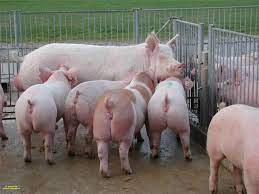Management Practices in Pig Production
In this article you will learn about the various things you need to do on your pig production business or farm in order to ensure that your pigs are healthy and your farm is doing well. The activities are referred to as management practices.
Different classes of pigs need to be managed in appropriate manner to attain and maintain high productivity and profitability
Management Practices in Pig Production
Various management practices require in a farm are described below.
1. Creep Feeding
Young piglets from 10 days onwards should have a high protein diet available to them. They have to be fed in small creep area where the mother cannot eat the feed.
The feed conversion rate of young piglets is very high thus creep feeding is particularly economical.
Creep feeding is very important as the piglets become used to feeding on solid food at an early age; the sows’ milk begin to decrease just as the piglets require more feed.
2. Provision of Iron
It is necessary for piglets to be given iron this can be in the form of an injection of 2ml iron dextran, or as pills or in their creep feed or swab the sow’s teats with an appropriate solution that contains iron or copper, like ferrous sulphate, or administer in water daily, for the first five days of life.
If piglets are reared on a concrete floor, provide clean soil or earth (sod) which is of up-rooted grass with both roots and earth intact at a corner of the pen as a source of iron and copper.
By observing good management and sanitary practices as mentioned above the piglets will double their birth weights within five to eight days. At weaning i.e. between four to six weeks of age they should weigh 10-12 times more than their birth weight.
Growth rates in large litters are usually less uniform than smaller ones. Bigger piglets usually prefer the better front teats and so gain more weight and faster than the rest. Piglets usually stick to teats they started with.
3. Needle Teeth Removal
Piglet needle teeth should be clipped off with a pair of clippers to prevent them from wounding their sow’s teat which might make her refuse them suckling.
4. Castration

Castration is the act of removing the testicles of a male animal to render them ineffective.
This operation is carried out on all unwanted males in the herd. This management operation prevents unwanted breeding and improves the carcass quality of the animal.
Read Also : Pig Feeding and Nutritional Requirements
It can be carried out by surgically operation or bloodlessly by the use of a burdizzo or rubber ring elastrator after the animal must have been haltered.
Surgical operation is done within the first week of the animal’s life while the bloodless one could be done within the first two weeks of life.
5. Tail Docking
The tails of ruminants are cut in a process called docking. This is practiced especially in sheep within one week of life.
Long tails in sheep at times do not make for good mating at adult age. An elastrator could be used at times to dock the animal and the wound treated. At this age the pain is minimized.
6. Culling of Sows
To maintain overall productivity in the herd, it is important to have a culling policy so that sows removed at the correct time.
The reasons for culling include; Lameness, other injuries, farrowing problems, poor litter-size, poor mothering ability, and low fertility.
A sow that regularly produces a good litter will eventually start to decline with age, probably around her tenth litter if she is producing well; a god guide is to allow her to remain in the herd until her performance falls below the average of the gilts in the herd.
At the same time, it is important to have a supply of pregnant gilts available to replace sows that need to be culled.
7. Marking and Identification
EarTagging: This is done for identification purposes. The animal is haltered and the tag is placed in the applicator then clamped to the pina of the ear.
Caution must be taken not to damage the blood vessels on the pina. Other operations for identification includes: tattooing, ear notching, skin branding, horn branding and the use of neck chains or tags- either plastic or metals.
Tattooing: This is the art of drawing a design on the body of the animal that is peculiar to the animal and well known by the farm manager.
Ear notching is cutting the ears in a particular shape and coding the shape. It involves the use of razor or scissors to cut a “V” shape on the tip of the pina.
The positions of the cut indicate numbers. If it is at the top of the pina it denotes 1, if at the tip, 5 and if under, it is 3. The right ear represents tens while the left represent units. The two are added to give the animal an identification number in the herd.
Skin and horn branding are very common in our local setting. Hot iron is used to write numbers and at times names of owners of the animal on their skin or horn. This practice is very common with cattle.
In summary, appropriate management practices are necessary for good growth and development of pigs on the farm. The husbandry man should therefore have these skills available at his finger tips
The management practices such as creep feeding, iron supplementation and their importance to piglets, as well as how to carry out some practices such as castration, animal identification, docking, culling etc. which are very important in a farm.
Read Also : Characteristics of Municipal Solid Waste (MSW)









